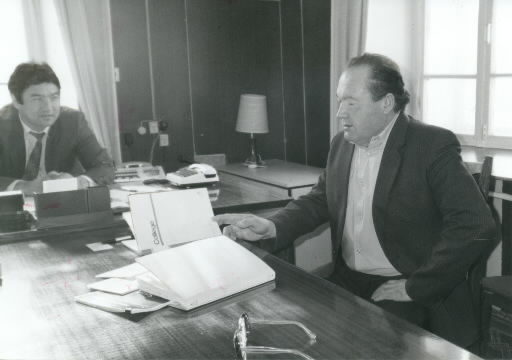6. Secret Research Carried Out by the Military
Jan. 21, 2013
Chapter 2: Soviet Union
Part 1: The Largest Nuclear Test Site in the Nation
Part 1: The Largest Nuclear Test Site in the Nation
During the forty-year period in which over three hundred nuclear tests were carried out on the plains of Kazakhstan, the military never deviated from its standard line of "Don't worry, there's no problem." In actual fact, though, it was quietly conducting its own investigations into the effects of radiation.
This secret research was carried out in a corner of a run-down wooden building housing the Semipalatinsk Provincial Health Department. The research laboratories were known as Section Four: a sign on the door indicated a department specifically for the study of a certain sheep disease that plagues farms in the area. The rooms, however, have not once been used for studying sheep diseases.
Only doctors and scientists directly related to the military were allowed to enter. Radiation measurements and health investigations were carried out here, right under the citizens' noses, but they were told nothing.
The deception was uncovered in October 1989 by members of the movement to close the test site; the sign on the door now reads "Radiation Medicine." Despite the abrupt change of image, though, the locals still call it Section Four in defiance of the bureaucrats who lied to them for so long.
The research secretly carried out in Section Four began in 1961, twelve years after the first test. The code name Semipalatinsk Forty was given to the work, which was conducted in collusion with the Department of Health in Moscow and the local military commander. A total of 125 staff were employed, including twenty-five doctors.
To this day, no results of any research carried out by the staff of Section Four have been used for the benefit of the local residents, either before or after its true activities were disclosed.
We interviewed Dr. Boris Guchev, who has been involved in the research at Section Four for many years and is widely believed to hold the key to the mysteries of the work carried out there.
Reporter: Why was it necessary to put up a fake sign to trick the residents?
Guchev: We were just following orders.
R: What were you studying?
G: We made regular checks on the level of radiation around the site and investigated the health of ten thousand of the residents there.
R: Did people know why the checks were being carried out?
G: The military had told them that there were no harmful effects from the tests, so we couldn't very well tell them what we were checking for.
R: What were the results of these checks?
G: We found slightly higher rates of cancer and leukemia than usual. But I can't say for certain whether these were brought on by radiation. In the early stages our survey techniques were somewhat primitive, so it's difficult to make comparisons.
R: Did you find any genetic defects?
G: I can't say.
R: Could you tell us about the results of your surveys in a little more detail?
G: I don't have the authority. I'm afraid I can't disclose anything right now.
R: Did problems caused by high doses of radiation decrease when testing moved underground?
G: The situation did improve. But I have heard that there were instances of radiation leaking up through the ground--as the military say happened in February 1989.
R: Don't you think all the material you gathered should be released as soon as possible for the sake of the residents?
G: I can't reveal anything without the proper authorization.
Interviewing Guchev was like getting blood out of a stone, and at times there were some very long pauses. The head of the provincial health department, who was present at the interview, stayed silent the whole way through. His deputy, who sat looking annoyed during most of the interview, finally told us, "Look, there are 840,000 people in this province, so the sample of 10,000 people used by Section Four is just too small. We need to expand the sample to at least 100,000 and conduct some joint research." On this note, our interview was concluded.
Glasnost as promoted by Mikhail Gorbachev has given the people of Kazakhstan the confidence to question the past and the present, as is shown by the growth of the Nevada-Semipalatinsk movement. Unfortunately, as far as the problem of nuclear testing is concerned, there is still much room for improvement. That was one thing we did learn from our interview with Dr. Guchev.








